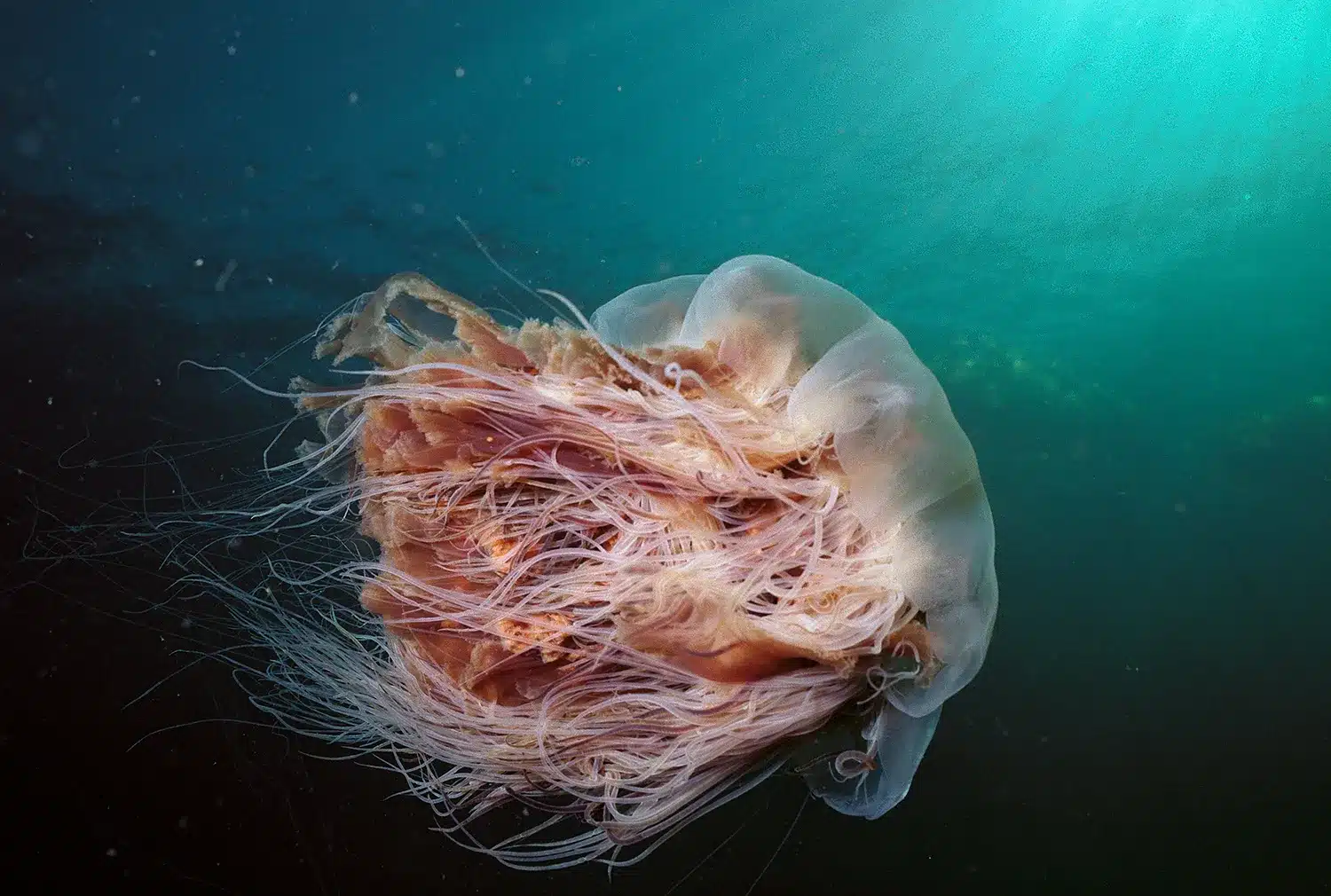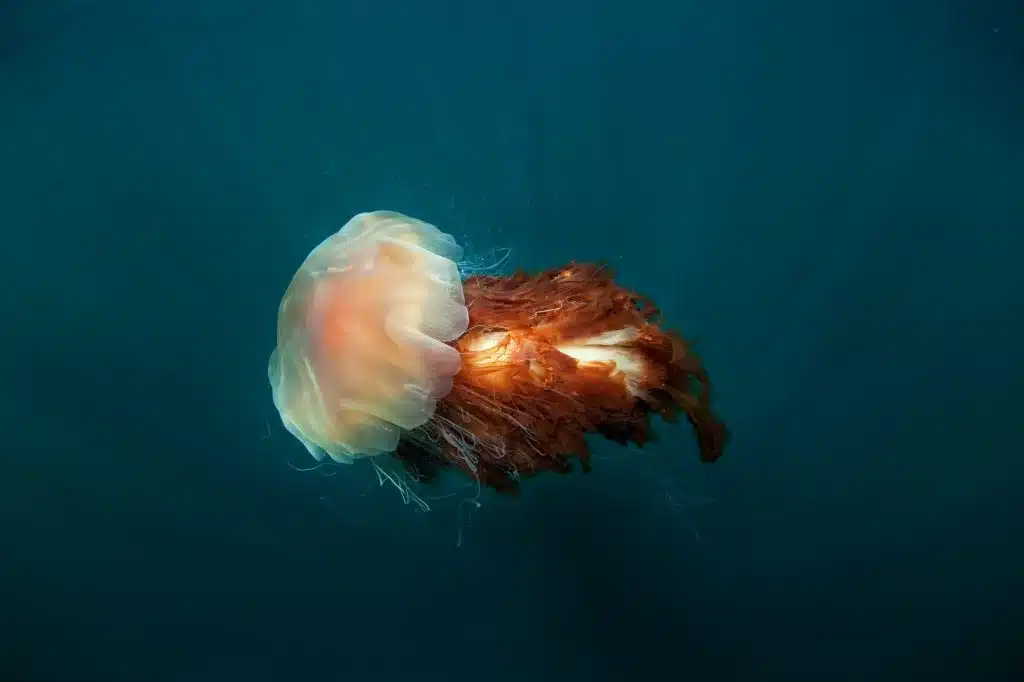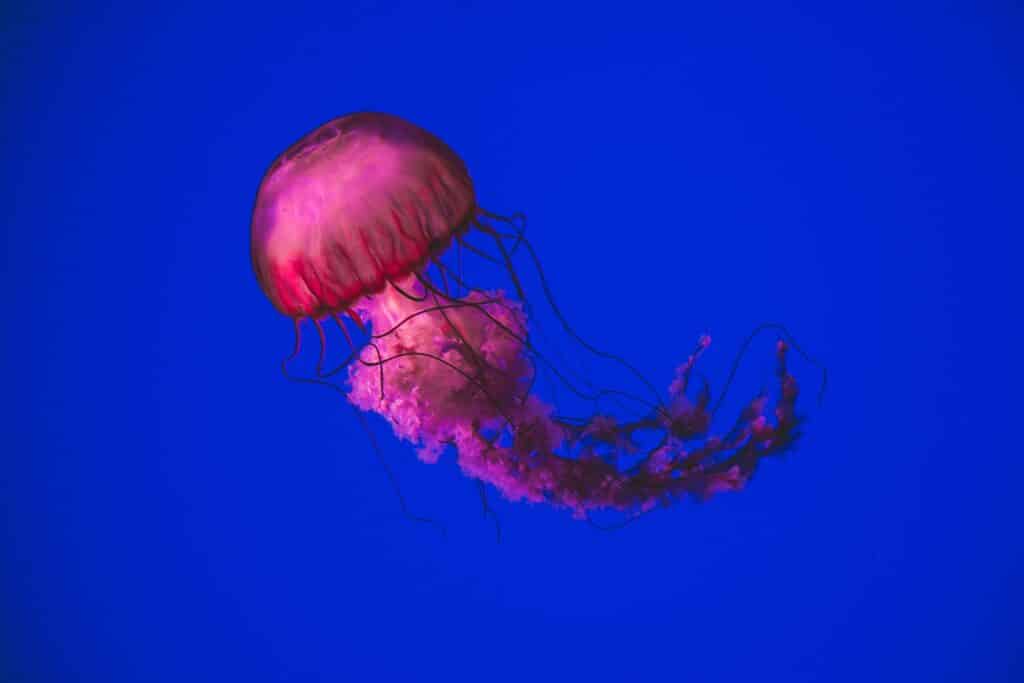How Long Do Jellyfish Live

Introduction
How Long Do Jellyfish Live: Jellyfish, those ethereal creatures that drift through the world’s oceans, have long captivated the imagination of scientists and nature enthusiasts alike. Their seemingly otherworldly appearance and graceful, pulsating movements belie a fascinating and enigmatic existence beneath the waves. One of the most intriguing aspects of jellyfish biology is their lifespan, which varies significantly among different species and is still not fully understood.
In this exploration of the longevity of jellyfish, we delve into the mysteries of their existence. These gelatinous organisms, belonging to the phylum Cnidaria, are ancient inhabitants of our planet, with a lineage dating back over 500 million years. Despite their primitive nature, jellyfish display an incredible diversity of life spans, with some species living only a few hours, while others can persist for several years.
Understanding the factors that influence the lifespan of jellyfish is essential not only for unraveling the secrets of their biology but also for gaining insights into the broader ecological dynamics of the marine environments they inhabit. Factors such as environmental conditions, predation, reproduction. Join us on this journey through the oceans to uncover the secrets of these mesmerizing, ancient creatures.

Do jellyfish have a lifespan?
Most jellyfish are short lived. Medusa or adult jellyfish typically live for a few months, depending on the species, although some species can live for 2-3 years in captivity. Polyps can live and reproduce asexually for several years, or even decades. One jellyfish species is almost immortal.
Jellyfish do indeed have lifespans, but the duration varies significantly among different species. Some jellyfish species have relatively short lifespans, measured in hours or days. These are often the small, delicate jellyfish commonly found near coastal areas. Their brief lives are primarily focused on reproduction, as they quickly mature, release their eggs or sperm, and then die shortly afterward.
On the other end of the spectrum, there are jellyfish species with remarkably long lifespans, which can extend for several years. The notable example of such longevity is the Turritopsis dohrnii, often referred to as the “immortal” jellyfish. This unique species has the extraordinary ability to revert to a juvenile stage after reaching maturity, effectively escaping the conventional concept of aging and death.
In between these extremes, many jellyfish species fall into the category of living for several months to a few years, depending on environmental conditions and factors like predation and food availability. Thus, the lifespan of a jellyfish depends on various biological and ecological factors, making it a subject of ongoing scientific inquiry and fascination.
How long do immortal jellyfish live for?
Forever
The immortal jellyfish can regenerate and live forever.
The immortal jellyfish, sometimes called the Benjamin Button jellyfish, is one of the only known animals that possess full regenerative capabilities, as well as being the only species of jellyfish with an indefinite lifespan.
The immortal jellyfish, scientifically known as Turritopsis dohrnii, has garnered significant attention due to its unique ability to seemingly evade death and aging. While the term “immortal” is often associated with this species, it’s essential to clarify that they are not truly immortal in the sense of living forever. Instead, their remarkable characteristic is “biological immortality.”
The key to the Turritopsis dohrnii’s extraordinary longevity lies in their ability to revert back to an earlier stage in their life cycle after reaching maturity. When faced with adverse conditions or threats, such as predation, disease, or starvation, these jellyfish can transform their adult cells into specialized cells called “youth cells” through a process called transdifferentiation. This essentially resets their biological clock and allows them to start their life cycle anew.
While the exact lifespan of the Turritopsis dohrnii is challenging to determine precisely, they have the potential to extend their lives significantly compared to other jellyfish species. They can cycle through their life stages repeatedly, potentially living for several years under favorable conditions. However, their survival ultimately depends on various factors like the availability of food, water quality, and the absence of significant threats.
Intriguingly, the study of these “immortal” jellyfish provides valuable insights into the mechanisms of aging and regeneration, with potential implications for scientific research in various fields, from medicine to biotechnology.
How old is the oldest jellyfish?
505-Million-Year-Old
The specimens are evidence of how little the squishy, tentacled predators have changed over the history of life on Earth.
Determining the age of the oldest jellyfish can be challenging due to the elusive nature of these creatures and their propensity for transience. Unlike long-lived organisms such as trees or certain marine animals, jellyfish generally have relatively short lifespans.
The Turritopsis dohrnii, often referred to as the “immortal” jellyfish, is one of the few species known to exhibit a unique form of rejuvenation and potential longevity. However, even for this remarkable species, accurately pinpointing the age of the oldest individual can be elusive.
The concept of age becomes somewhat blurred when discussing immortal jellyfish because they can revert to a juvenile stage after reaching maturity, effectively resetting their biological clock. As a result, it’s challenging to assign a specific age to a Turritopsis dohrnii.
While some individuals of this species have been observed living for several years under favorable conditions, and laboratory studies have demonstrated their ability to cycle through their life stages repeatedly, exact age records are scarce. Additionally, in the wild, many factors like predation, disease, and environmental changes can impact their longevity.
While we can appreciate the potential for extended lifespans in certain jellyfish species like the Turritopsis dohrnii, quantifying the age of the oldest jellyfish remains a complex and evolving area of scientific study.
What happens if a jellyfish dies?
Even if the jellyfish is dead, it can still sting you because the cell structure of nematocysts is maintained long after death. Nematocysts release a thread that contains the venom when a foreign object brushes against the cell and will continue releasing venom until the cells are removed.
When a jellyfish dies, its fate largely depends on its environment and the circumstances of its demise. Here’s what typically happens to a deceased jellyfish:
Decomposition: Like most organisms, jellyfish undergo decomposition after death. Bacteria and other microorganisms break down the jellyfish’s tissues, releasing nutrients back into the aquatic ecosystem. This decomposition process can happen relatively quickly, particularly in warm, nutrient-rich waters.
Consumption by scavengers: Dead jellyfish can become a source of food for various marine scavengers and detritivores. Animals such as crabs, fish, sea anemones, and certain sea birds are known to feed on jellyfish carcasses.
Sinking: In some cases, dead jellyfish may sink to the ocean floor. Here, they can provide sustenance to bottom-dwelling organisms, contributing to the nutrient cycling in marine ecosystems.
Drifting: Depending on water currents and ocean conditions, a deceased jellyfish might continue to drift along with the currents for some time before eventually decomposing or being consumed by scavengers.
It’s worth noting that jellyfish are fragile creatures, and their bodies consist primarily of water, which can make them disintegrate relatively quickly after death. Their life cycle is tightly integrated into the marine food web, and their demise, like their existence, has implications for the broader ecosystem.
Can jellyfish live without water?
As soon as the jellyfish is dropped on the beach by the retreating tide, the jellyfish begins to die. A jellyfish breathes by taking in oxygen from the seawater through its skin so as soon as it is on dry land it can no longer live.
Jellyfish, fascinating creatures of the sea, are exquisitely adapted to life in water, and their existence is intimately tied to aquatic environments. They are composed of over 95% water themselves, which gives them their gelatinous appearance and allows them to drift gracefully through the oceans. However, the question of whether jellyfish can live without water is a paradox, as they are fundamentally aquatic animals.
Once removed from their natural habitat, a jellyfish’s delicate biology becomes vulnerable. They rely on water for buoyancy, support, and the exchange of essential substances. Without water, their fragile bodies would collapse, and they would be unable to maintain their shape and structure. Additionally, oxygen and nutrients are absorbed through their skin from the surrounding water, a process essential for their survival.
In essence, jellyfish cannot exist without water, making them a quintessential example of marine life intricately linked to their watery realm. Any attempt to separate them from their aquatic home would inevitably lead to their demise, emphasizing the importance of preserving their natural habitats for the health of our oceans and the preservation of these captivating creatures.
What factors influence the lifespan of a jellyfish?
The lifespan of a jellyfish is a complex interplay of various factors that determine how long these enigmatic creatures can survive in their aquatic world. Several key factors influence their lifespan:
- Species: Different species of jellyfish have varying lifespans. Some species, like the moon jellyfish, may live for only a few months, while others, such as the Turritopsis dohrnii (immortal jellyfish), have the remarkable ability to revert to a juvenile state and potentially extend their lives significantly.
- Environmental Conditions: The environment in which a jellyfish resides plays a critical role. Factors like water temperature, salinity, and food availability can greatly impact their lifespan. Warmer waters may accelerate their metabolic processes, potentially shortening their lifespan, while stable conditions may support longer lives.
- Predation: Jellyfish are prey to a variety of marine organisms, including turtles and certain species of fish. The level of predation pressure in their habitat can significantly affect their survival.
- Reproduction: Reproduction can be both a cause and consequence of lifespan. Some jellyfish reproduce sexually, while others use a process called budding. Reproduction often marks the end of their life cycle, as they may deteriorate after spawning.
- Human Impact: Pollution, climate change, and habitat destruction caused by human activities can harm jellyfish populations. These anthropogenic factors can reduce their lifespan by disrupting their food sources and habitats.
The lifespan of a jellyfish is intricately tied to their biology and the conditions of their environment. Understanding these factors is crucial not only for unraveling the mysteries of these fascinating creatures but also for preserving the delicate balance of marine ecosystems they inhabit.
Can jellyfish live in captivity for an extended period?
Jellyfish can indeed live in captivity for an extended period under the right conditions. Unlike many other marine creatures, they can adapt to life in an aquarium if their specific needs are met. Creating a suitable environment is crucial for their long-term survival.
To thrive in captivity, jellyfish require a well-maintained tank with stable water parameters, including appropriate temperature and salinity levels. They are highly sensitive to changes in water quality, so filtration systems and regular water testing are essential. Additionally, a specialized circular flow system is often used to prevent the jellyfish from getting stuck in corners and to mimic the gentle ocean currents they’re accustomed to.
Feeding jellyfish in captivity can be challenging as they primarily consume plankton in the wild. Aquariums often use specially formulated diets consisting of small particles or live brine shrimp to meet their nutritional needs.
While some species of jellyfish can survive for several years in captivity, their lifespans are generally shorter than those in the wild due to the inherent challenges of replicating their natural habitat. Nonetheless, with dedicated care and attention to their specific requirements, it is possible to enjoy the mesmerizing presence of these graceful and delicate creatures in an aquarium for an extended period.
How do jellyfish reproduce, and does it affect their lifespan?
Jellyfish reproduction is a complex and adaptable process that varies among different species. While it may not directly impact the lifespan of individual jellyfish, it plays a crucial role in the overall survival and population dynamics of these gelatinous organisms.
During favorable periods with ample food and suitable temperatures, jellyfish may predominantly engage in sexual reproduction, producing a diverse genetic pool of offspring. This genetic diversity can enhance their ability to adapt to environmental changes and threats, increasing their chances of long-term survival.
Conversely, when conditions become less favorable, such as in overpopulated or nutrient-depleted environments. This rapid and efficient method enables them to produce large numbers of genetically identical individuals, allowing them to capitalize on available resources and potentially dominate their ecosystem temporarily.
While the individual lifespan of a jellyfish can vary depending on the species and environmental factors, their reproductive strategies have evolved to maximize their overall success as a species. This adaptability ensures that jellyfish continue to thrive in the ever-changing world of the ocean.

Conclusion
The study of jellyfish lifespan has revealed a captivating tapestry of adaptability and resilience in these remarkable creatures. From the ephemeral existence of some species to the enduring longevity of others, the diversity of jellyfish lifespans continues to intrigue scientists and deepen our understanding of marine ecosystems.
We’ve learned that environmental factors, such as temperature, food availability, and predation pressures, play a significant role in determining how long a jellyfish will live. But perhaps one of the most astonishing discoveries is the phenomenon of jellyfish immortality. Some species, like the Turritopsis dohrnii, have the remarkable ability to revert to a juvenile stage after reaching maturity, essentially allowing them to bypass death and live indefinitely under ideal conditions.
The knowledge gained from studying jellyfish lifespans not only contributes to our understanding of these ancient oceanic inhabitants but also holds broader implications for marine conservation and ecosystem management. With their population dynamics intricately linked to environmental health, changes in jellyfish populations can serve as indicators of larger ecological shifts in our oceans.
As we continue to explore the mysteries of jellyfish lifespan, we are reminded of the vital importance of preserving these mesmerizing creatures and the delicate ecosystems they inhabit. Our journey into the depths of the sea and the longevity of jellyfish serves as a poignant reminder of the intricate web of life that sustains our planet’s oceans.



